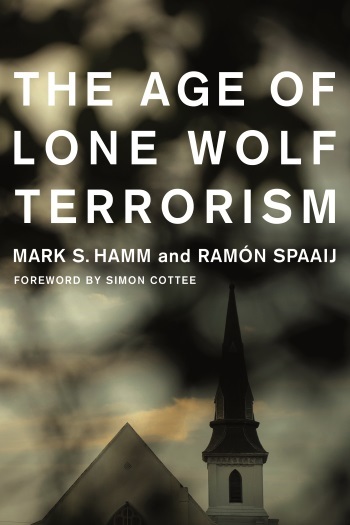By Mark S. Hamm and Ramón Spaaij
Foreword by Simon Cottee
The lethality of lone-wolf terrorism has reached an all-time high in the United States. Isolated individuals using firearms with high-capacity magazines are committing brutally efficient killings with the aim of terrorizing others, yet there is little consensus on what connects these crimes and the motivations behind them.

In The Age of Lone Wolf Terrorism, terrorism experts Mark S. Hamm and Ramón Spaaij combine criminological theory with empirical and ethnographic research to map the pathways of lone-wolf radicalization, helping with the identification of suspected behaviors and recognizing patterns of indoctrination.
Reviewing comprehensive data on these actors, including more than two hundred terrorist incidents, Hamm and Spaaij find that a combination of personal and political grievances lead lone wolves to befriend online sympathizers—whether jihadists, white supremacists, or other antigovernment extremists—and then announce their intent to commit terror when triggered. Hamm and Spaaij carefully distinguish between lone wolves and individuals radicalized within a group dynamic.
This important difference is what makes this book such a significant manual for professionals seeking richer insight into the transformation of alienated individuals into armed warriors. Hamm and Spaaij conclude with an analysis of recent FBI sting operations designed to prevent lone-wolf terrorism in the United States, describing who gets targeted, strategies for luring suspects, and the ethics of arresting and prosecuting citizens.
Columbia University Press | May 2017
ISBN 9780231181747
Contents
Foreword
Introduction: The Age of Lone Wolf Terrorism
View chapters
1. Identifying Commonalities Among Lone Wolf Terrorists
2. Old Wine in New Skin: Reimagining Lone Wolf Terrorism
3. The American Lone Wolf Terrorist: Trends, Modus Operandi, and Background Factors
4. The Roots of Radicalization
5. The Enablers
6. Broadcasting Intent: The Key to Preventing Lone Wolf Terrorism
7. Triggering Events
8. The Radicalization Model of Lone Wolf Terrorism
9. The Little Rock Military Shooting
10. The Pittsburgh Police Shooting
11. Lone Wolf Sting Operations
12. Lone Wolf Terrorism and FBI Mythmaking
Conclusion: Countering Lone Wolf Terrorism
Appendix: List of Cases
Notes
Index
“The enduring merit of The Age of Lone Wolf Terrorism is that it provides an empirically robust and theoretically nuanced framework for addressing how ordinary individuals can become the agents of extraordinary violence and destruction.”
from the foreword by Simon Cottee
What people are saying
“Covering characters as diverse as James Earl Ray, Sirhan Sirhan, Mark Essex, Lynnette “Squeaky” Fromme, Ted Kaczynski, Eric Rudolph, Jared Loughner, Wade Page, and Christopher Dorner, Hamm and Spaaij have written an excellent and well-researched survey of lone wolf terrorists in the United States—and a major addition to the field.”
Charles B. Strozier, founding director, Center on Terrorism at John Jay College of Criminal Justice
“The study of lone wolf terrorism takes a significant leap forward in this important book. Hamm and Spaaij provide a thoughtful analysis and critical insights about the nature of lone wolf terrorism and terrorists. The book is a must-read for scholars, policymakers, and law enforcement officials.”
Steven Chermak, Michigan State University
“A careful, detailed, original contribution to a vitally important debate.”
Richard English, Queen’s University Belfast
Read more
“Defined variously as a ‘radical loser,’ a ‘lunatic assassin,’ or more grandiosely as a symptom of our fractured political age, the lone wolf terrorist is a much-commented-upon but frequently misunderstood phenomenon. Thankfully, with the publication of Hamm and Spaaij’s compelling new work, The Age of Lone Wolf Terrorism, we now have the definitive resource with which to explore both the mindset and the motivations of this most perplexing of political extremists. Crisply written and extraordinarily rich in empirical detail, this is essential reading for students of terrorism, criminologists concerned with political violence, and anyone else interested in the evolving nature of late modern radicalization.”
Keith Hayward, University of Copenhagen
“A searing, eye-opening, and comprehensive depiction of the evolving nature of terrorism in the United States, The Age of Lone Wolf Terrorism is certain to become essential reading for anyone interested in understanding both the factors leading to terrorism and new ways of approaching counterterrorism. Hamm and Spaaij’s detailed analysis of the connection between personal circumstances and contemporary social and political realities shed light on aspects of terrorism that are all too often overlooked. Their work is an indispensable primer for policy makers, counterterrorism experts, and students of terrorism.”
Karen J. Greenberg, Director, Center on National Security, Fordham University
“Hamm and Spaaij have done us all, as citizens in a world increasingly vulnerable to lone wolf terrorism, a service in their comprehensive analysis of this phenomenon.”
Padraig Collins, PsycCritiques
“Exceptional from a scholarly point of view, while also providing crucial insights that can help towards devising effective policy responses to lone wolf terrorism.”
Christos Balafoutis, British Journal of Criminology
“Genuinely indispensable.”
Matthew Feldman, Times Higher Education
“The authors make a compelling, data-backed argument that political violence committed by lone offenders has been steadily increasing for decades, and that this increase is particularly marked in the United States.”
Journal of Communication
“A useful introduction into the history of lone wolf terrorism in the United States.”
H-War
“A book bursting with insight and precision that leaves little to be desired. […] I applaud their effort to not only influence larger political changes, but also to suggest life-saving procedures we can apply on the road to social emancipation.”
Crime, Media, Culture: An International Journal
“If you read only one book on lone wolf terrorism, this should be it. It sets the benchmark on what we know about this threat and what can be done to safeguard the future. Superb.”
Andrew Silke, University of East London
“A searing, eye-opening, and comprehensive depiction of the evolving nature of terrorism in the United States, The Age of Lone Wolf Terrorism is certain to become essential reading for anyone interested in understanding both the factors leading to terrorism and new ways of approaching counterterrorism. Hamm and Spaaij’s detailed analysis of the connection between personal circumstances and contemporary social and political realities shed light on aspects of terrorism that are all too often overlooked. Their work is an indispensable primer for policy makers, counterterrorism experts, and students of terrorism.”
Karen J. Greenberg, Director, Center on National Security, Fordham University
“Hamm and Spaaij yield several unique findings that upend established terrorism expertise […] The Age of Lone Wolf Terrorism does manage to break the typical mould of terrorism studies.“
Kris Millett, Critical Studies on Terrorism
“The Age of Lone Wolf Terrorism provides an important data-driven extension to our current understanding of who lone wolves are and the factors that led them to undertake the acts that they did. It is a well-researched and dynamic read that seamlessly flows between quantitative analyses and qualitative deep-dives.”
Neil Shortland, Theoretical Criminology
“An impressive examination of the rise of lone wolf terrorism and its implications for Western counter-terrorism strategy. […] Highly recommended.”
CHOICE: Current Reviews for Academic Libraries
“This book presents a compelling look at how lone wolf terrorists are made over time, not born. […] For security professionals trying to understand the lone wolf threat, this book provides an excellent reference.”
Bill Scott, CPP, Security Management
“An outstanding manual for professionals and criminology students, as well as an interesting (and easy to understand) book for everyone.”
The Serial Reader
Mark S. Hamm
Co-Author
Mark S. Hamm is a professor of criminology at Indiana State University and a senior research fellow at the Center on Terrorism, John Jay College of Criminal Justice. His books include Terrorism as Crime: From Oklahoma City to Al-Qaeda and Beyond (2007) and The Spectacular Few: Prisoner Radicalization and the Evolving Terrorist Threat (2013).
Ramón Spaaij
Co-Author
Ramón Spaaij is a sociologist based at Victoria University and the University of Amsterdam. His books include Understanding Football Hooliganism (2006), Understanding Lone Wolf Terrorism: Global Patterns, Motivation, and Prevention (2012), and Sport and Social Exclusion in Global Society (2014).
The Age of Lone Wolf Terrorism

Related Writing
Understanding the El Paso Massacre on the Columbia University Press Blog
The Meaning of Lone Wolf Terrorism by Mark Hamm on the Columbia University Press Blog
